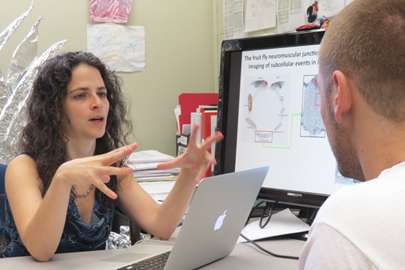Progress in the fight against ALS

A Brandeis research group has found a way to repair a vital signaling mechanism in fruit flies with symptoms of ALS. As a result, dying motor neurons regained health and the once paralyzed flies regained partial motion.
The discovery represents a significant breakthrough in our understanding of what goes wrong in ALS when signals called growth factors travel from around the body to the spinal cord where they promote the growth and survival of motor neurons. It's the eventual failure of motor neurons in patients with ALS that leads to muscle decay.
"We didn't cure ALS in the flies," says Rodal, "but we did make them significantly better."
The work was done in the lab of assistant professor of biology Avital Rodal. It appeared online in mid-August in Molecular Biology of the Cell. Financial support came from The Blazeman Foundation for ALS Research.
ALS, short for amyotrophic lateral sclerosis and also known as Lou Gehrig's disease, is a neurodegenerative illness where muscles waste away, leading to the inability to speak, move and eventually breathe. Around 30,000 people in the United States suffer from the illness. Patients typically die three to five years after the onset of symptoms. In 2014, The Ice Bucket Challenge, where participants dumped a bucket of ice on their heads, raised new awareness about the disease.
Rodal works with files that have been genetically modified to contain mutations similar to those found in humans with ALS. Her research focuses on vesicles, which are essentially membranous suitcases packed with growth factor molecules. Some get manufactured in the limbs where nerve endings make contact with muscle tissue. They then travel along the nerves' fibers or axons to the spinal cord where the nerve cell nuclei are located. Axons can stretch several feet long so the vesicles rely on "motors" to propel them quickly toward the spine.
In people with ALS, something malfunctions so that the growth factor doesn't wind up effectively communicating with motor neurons, triggering cell death. The big mystery is what exactly is going wrong.
Researchers in Rodal's lab found that the problem occurred at the start of the vesicle's trip in the nerve endings. In the ALS model fruit flies, the growth factors were packaged into the wrong kind of vesicles, and the movement of vesicles was faster and ranged over larger distances than in fruit flies without ALS.
Finding this abnormal vesicle movement was a major breakthrough. Rodal could now modify the fly's genes so the vesicles moved more like they do in healthy specimens. This gene modification also restored growth factor function, and the neurons recovered enough to allow the flies to crawl more efficiently.
"If we find a way to tweak the same trafficking machinery in patients as we modified in the fly," Rodal says, "it might be a way to help return their neurons to a healthy state."
More information: M. Deshpande et al. Role of BMP receptor traffic in synaptic growth defects in an ALS model, Molecular Biology of the Cell (2016). DOI: 10.1091/mbc.E16-07-0519


















